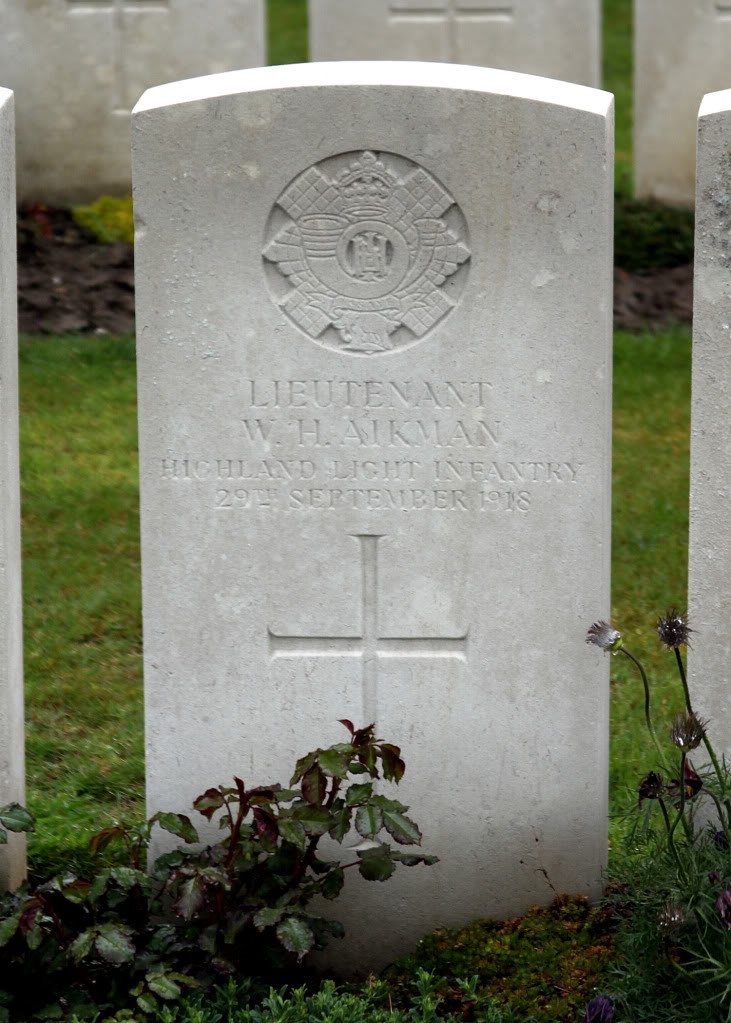Other Information
Attended Merchiston Castle School, Edinburgh 1908-10. Census 1911 at Ferry Hill, Tigh-na-Mara, Wilfred H. Aikman (17) born Dunfermline, Bank Clerk, son of William C. Aikman (55) born Dunfermline, Linen Manufacturer and Margaret Aikman (55) born Lanark.
Wilfred joined the army as Private 2713 in the 4th Bn, Royal Scots. He was commissioned as a 2nd Lieutenant in the 1st/6th Battalion Highland Light Infantry with effect from 6 June 1915.

This was a Territorial battalion. He arrived in Gallipoli on 1 December 1915 some six months after the battalion had arrived and just in time for the withdrawal on 6 January 1916. At the time of his arrival the battalion appear to have been in the line at Achi Baba Nullah. They seem to have worked a rota of one week in the forward trenches, followed by four days in the rest area, however this area was under shellfire and occasionally also bombed by enemy
aircraft.
On 8 January 1916 they began to be evacuated over the beaches, initially to Mudros and then onward to Egypt, arriving at Alexandria on 4 February.
They spent the next month being re-equipped and undergoing training prior to moving east of the Suez Canal and sending patrols towards the enemy.
The battalion were part of 157th Brigade (along with the 1/7 and 1/7 Bns) serving in the 52nd Lowland Division.
Although there were some minor skirmishes and attacks by enemy aircraft, most of the time was spent in training until 5 August, when they began a limited advance. His battalion war diary records the fact that on the 25th August 1916 he was wounded and admitted to hospital after returning with his Lewis Machine Gun Team from their front line post N9 “Blair’s Post”, which seems to have been near “Hod er Rabah” or “Kilo 43”.
At this time he was the Lewis Gun Officer for C Company. He returned to active duty again on 12th September 1916.
The battalion seems to have been heavily involved in training, including the use of baggage camels, until advancing on 15 October 1916 to Salmana.
His promotion to temporary lieutenant was gazetted on 12th March 1917 with effect from 18th December 1916 and on 20 March 1917 he was seconded to the staff as a Railway Transport Officer (back dated to 1 January).
By this time the battalion appears to have advanced to the vicinity of Gaza, but had not been involved in heavy fighting. Wilfrid’s exact duties on the staff have not been determined, but in general RTOs acted as a liaison between the army and the civilian railway authorities.
They also acted as a kind of military travel agent, arranging for men and supplies to be put on the correct train. They were also expected to ensure that sufficient vehicles were available to convey the traffic, while insisting that the units involved neither overloaded the train, nor spread themselves out and waste valuable loading space. These were heavy responsibilities for a junior officer. His promotion to Lieutenant was confirmed, being gazetted on 18th July 1917 with effect from 1st June 1916.
It is unclear when Wilfrid re-joined the battalion, which early in November 1917 was engaged a successful attack near Esdud, but he was promoted to takeover command of C Company on 25th November 1917 at Beit Izza. The diary for December appears to be missing, but in January they were at Al Haram and once again mainly engaged in training for most of the month.
In March they were in the line at Balutah. They sailed for France in April 1918, In July they were at Vimy and by August, the battalion were serving in the Arras sector near Oppy.
The war diary records that Wilfred returned to the UK for 14 days leave on the 8th August 1918 (this was recorded as the black day for the German Army as the allies launched their massive offensive against the Germans at Amiens). Sadly, this would prove to be Wilfred’s last visit to the UK. On 24 August the unit were engaged in an attack on the Hindenberg Line and sustained heavy casualties. It is unclear on what day Wilfrid was hurt, but he died of wounds on 29th September 1918 – only some 6 weeks from the end of the war and at the time of his death appears to have been acting Captain.

